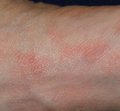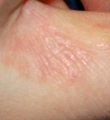Scabies is a skin disease caused by infestation with the mite Sarcoptes scabiei. Although it may infest any human in any climate, it is most common in children younger than two years and is endemic in the tropics. (1) The female mite, whose life expectancy is about 30 days, burrows into the epidermis to lay eggs. The eggs hatch into larvae in three to four days, and larvae mature into adults in 14 to 17 days. (2) Male adult mites are smaller than females, remain on the skin surface, and die shortly after mating. There is evidence that mites can live for up to three days without a human host, and a reported outbreak of scabies among laundry workers provides evidence that fomites may spread disease. (3) While animal strains of scabies exist and can infect humans, the mites cannot complete their life cycle or be passed to other hosts. (4)
Diagnosis
Symptoms of scabies infestation include rash and intense pruritus that is often worse at night. The lesions begin as tiny erythematous papules and can progress to vesicles or pustules. Linear burrows are a classic feature but are not seen commonly. Excoriation and ulceration also may be present, and a more generalized hypersensitivity reaction, including urticaria, may occur. In severe cases and in immunocompromised hosts, large areas of crusting may be seen.
Although outbreaks can occur almost anywhere, the axillae, web spaces between fingers, and flexor surfaces of the wrists are the most common areas. Male genitalia, female breasts, the gluteal crease, waistband, and antecubital fossae also are frequently affected. The face and scalp usually are spared except in infants. (5)
Typical distribution of lesions, intense pruritus, and patchy, discrete lesions with secondary excoriation signal scabies infection. The diagnosis usually is clinical but may be confirmed by skin scrapings near the newest and least disturbed skin lesions or under the fingernail edge. (6) Light microscopy of the scrapings may detect the female mite, eggs, and feces pellets (Figure 1).
[FIGURE 1 OMITTED]
Treatment
Topical sulfur treatments have been used for centuries to treat scabies infection. More recently, topical benzyl benzoate and lindane (Kwell) were mainstays of therapy. In 1990, a study (7) comparing lindane with topical permethrin (Nix) showed improved efficacy of permethrin at 28 days, with a lower risk for neurotoxicity. Topical permethrin was subsequently compared favorably with 10 percent crotamiton (Eurax) (8) and has became a widely used treatment for scabies (Table 1). (9)
Ivermectin (Stromectol) is related to macrolide antibiotics; it was developed in the 1970s as a veterinary treatment for animal parasites. (10) Ivermectin also has been used to treat animal scabies, which causes mange. (11) Ivermectin has been used in humans to treat millions of cases of onchocerciasis, other filariases, and intestinal nematodal infections such as strongyloidiasis. (12)
In 1993, a study (13) comparing oral ivermectin with topical 10 percent benzyl benzoate found that absolute results favored the use of ivermectin, but the difference was not statistically significant. Studies in Africa (14) and India (15) have suggested that an effective dosage of ivermectin is 200 mcg per kg; at least three additional studies (16-18) of the same dosage have confirmed ivermectin's efficacy as a treatment for scabies infection.
A small study of healthy patients and patients infected with human immunodeficiency virus (HIV) (16) showed that a single dose of ivermectin (200 mcg per kg) was curative in most patients. Several HIV-infected patients required a second dose two weeks later, and one patient needed a third dose of ivermectin plus topical permethrin to cure the infection. A randomized study of 53 patients that compared topical lindane with oral ivermectin showed that 15 days after treatment, 74 percent of patients who took ivermectin and 59 percent of patients who used topical lindane were cured; this difference was not statistically significant. (17) [Evidence level A, randomized controlled trial (RCT)] Four weeks after treatment, one patient treated with ivermectin and two patients treated with lindane had evidence of continuing infection. Another trial randomized 200 patients to oral ivermectin or topical lindane; 83 percent of patients treated with ivermectin were cured at four weeks compared up with 44 percent of patients treated with lindane. (18) [Evidence level B, lower quality RCT] However, complete follow-up was available in only 75 percent of patients.
Only one published study is available comparing oral ivermectin with topical permethrin. Patients were randomized to take a single dose of ivermectin (200 mcg per kg) or use topical 5 percent permethrin. (19) [Evidence level A, RCT] Fewer patients responded to ivermectin at the one- and two-week follow-ups than to permethrin. At the end of the second week, patients who did not respond to either treatment (12 in the ivermectin group and one in the permethrin group) repeated the dose. At the end of four and eight weeks, all but two patients in the ivermectin group and all patients in the permethrin group had been cured; this difference was not statistically significant. The study concluded that a single dose of permethrin was superior to a single dose of ivermectin.
Safety
An estimated 6 million people worldwide have taken ivermectin for various parasitic infestations. (15) No serious drug-related adverse events have been reported. Side effects of ivermectin include fever, headache, chills, arthralgia, rash, eosinophilia, and anorexia. (15) Many of these symptoms are thought to result from the death of parasites rather than as a reaction to the drug.
Ivermectin seems to be concentrated in the liver and fat tissue, with very low levels reaching the central nervous system. (20) No significant drug interactions have been reported. (21)
A study of elderly nursing home patients treated for scabies infection showed an increased death rate among ivermectin-treated patients, (22) but it was noted that this finding has not been confirmed in multiple subsequent trials.
Ivermectin is not approved for treatment of scabies by the U.S. Food and Drug Administration. There are concerns regarding its use in young children and pregnant women, because there may be more drug penetrance of the immature blood-brain barrier.
Role of Ivermectin
Although standard topical treatment of scabies is effective in many patients, there may be a particular role for oral ivermectin in refractory infestations or when compliance with head-to-toe application of topical agents is logistically difficult (e.g., large institutional outbreaks or mentally impaired patients). Immunocompromised patients with crusted scabies have very high parasite loads and also may benefit from oral treatment. Some authors recommend concomitant oral and topical treatment because systemic medication may not effectively penetrate thick, crusted areas. (22) Topical formulations of ivermectin also exist but have been less widely studied.
Cost
A single dose of ivermectin for a 70-kg (154-lb) adult costs about $38 (for three 6-mg pills) or about $67 for the same dose in 3-mg pills. Lindane (2 oz of 1 percent lotion) costs about $17, and permethrin (2 oz of 5 percent cream) costs about $38. (Retail prices provided by the author, rounded to the nearest dollar.)
The author indicates that he does not have any conflicts of interest. Sources of funding: none reported.
REFERENCES
(1.) Schmeller W. Community health workers reduce skin diseases in East African children. Int J Dermatol 1998;37:370-7.
(2.) Angel TA, Nigro J, Levy ML. Infestations in the pediatric patient. Pediatr Clin North Am 2000;47:921-35.
(3.) Thomas MC, Giedinghagen DH, Hoff GL. An outbreak of scabies among employees in a hospital-associated commercial laundry. Infect Control 1987;8:427-9.
(4.) Meinking TL, Taplin D. Advances in pediculosis, scabies, and other mite infestations. Adv Dermatol 1990;5:131-50.
(5.) Habif TP. Clinical dermatology: a color guide to diagnosis and therapy. 3d ed. St. Louis: Mosby, 1996:445-53.
(6.) Chosidow O. Scabies and pediculosis. Lancet 2000;355:819-26.
(7.) Schultz MW, Gomez M, Hansen RC, Mills J, Menter A, Rodgers H, et al. Comparative study of 5% permethrin cream and 1% lindane lotion for the treatment of scabies. Arch Dermatol 1990;126:167-70.
(8.) Taplin D, Meinking TL, Chen JA, Sanchez R. Comparison of crotamiton 10% cream (Eurax) and permethrin 5% cream (Elimite) for the treatment of scabies in children. Pediatr Dermatol 1990;7:67-73.
(9.) Centers for Disease Control and Prevention. 1998 guidelines for treatment of sexually transmitted diseases. Accessed July 2003 at: www.cdc.gov/epo/mmwr/preview/MMWRhtml/00050909.htm.
(10.) Blair LS, Campbell WC. Efficacy of ivermectin against Dirofilaria immitis larvae in dogs 31, 60, and 90 days after injection. Am J Vet Res 1980; 41:2108.
(11.) Lee RP, Dooge DJ, Preston JM. Efficacy of ivermectin against Sarcoptes scabiei in pigs. Vet Rec 1980;107:503-5.
(12.) Greene BM, Taylor HR, Cupp EW, Murphy RP, White AT, Aziz MA, et al. Comparison of ivermectin and diethylcarbamazine in the treatment of onchocerciasis. N Engl J Med 1985;313:133-8.
(13.) Glaziou P, Cartel JL, Alzieu P, Briot C, Moulia-Pelat JP, Martin PM. Comparison of ivermectin and benzyl benzoate for treatment of scabies. Trop Med Parasitol 1993;44:331-2.
(14.) Dunne CL, Malone CJ, Whitworth JA. A field study of the effects of ivermectin on ectoparasites of man. Trans R Soc Trop Med Hyg 1991;85:550-1.
(15.) Kar SK, Mania J, Patnaik S. The use of ivermectin for scabies. Natl Med J India 1994;7:15-6.
(16.) Meinking TL, Taplin D, Hermida JL, Pardo R, Kerdel FA. The treatment of scabies with ivermectin. N Engl J Med 1995;333:26-30.
(17.) Chouela EN, Abeldano AM, Pellerano G, La Forgia M, Papale RM, Garsd A, et al. Equivalent therapeutic efficacy and safety of ivermectin and lindane in the treatment of human scabies. Arch Dermatol 1999;35:651-5.
(18.) Madan V, Jaskiran K, Gupta U, Gupta DK. Oral ivermectin in scabies patients: a comparison with 1% topical lindane lotion. J Dermatol 2001;28:481-4.
(19.) Usha V, Gopalakrishnan Nair TV. A comparative study of oral ivermectin and topical permethrin cream in the treatment of scabies, J Am Acad Dermatol 2000;42:236-40.
(20.) Mai EC, Green WR, O'Brien TP. Update on therapy of parasitic retinal infections. Ophthalmol Clin North Am 1999;12:123-44.
(21.) Drug facts and comparisons 2002. 56th ed. St. Louis: Facts and Comparisons, 2002:1480-2.
(22.) Del Giudice P, Marty P. Ivermectin: a new therapeutic weapon in dermatology? Arch Dermatol 1999; 135:705-6.
Richard W. Sloan, M.D., R.Ph., coordinator of this series, is chairman and residency program director of the Department of Family Medicine at York (Pa.) Hospital and clinical associate professor in family and community medicine at the Milton S. Hershey Medical Center, Pennsylvania State University, Hershey, Pa.
ROBERT S. FAWCETT, M.D., M.S., is medical director of Thomas Hart Family Practice Center, affiliated with York Hospital Family Practice Residency in York, Pa. He received his medical degree from University of Iowa College of Medicine, Iowa City, and completed a residency at Ball Memorial Hospital in Muncie, Ind. He holds a certificate of added qualification in sports medicine.
Address correspondence to Robert S. Fawcett, M.D., M.S., 1001 S. George St., York, PA 17405 (e-mail: rfawcett@wellspan.org). Reprints are not available from the author.
COPYRIGHT 2003 American Academy of Family Physicians
COPYRIGHT 2003 Gale Group




